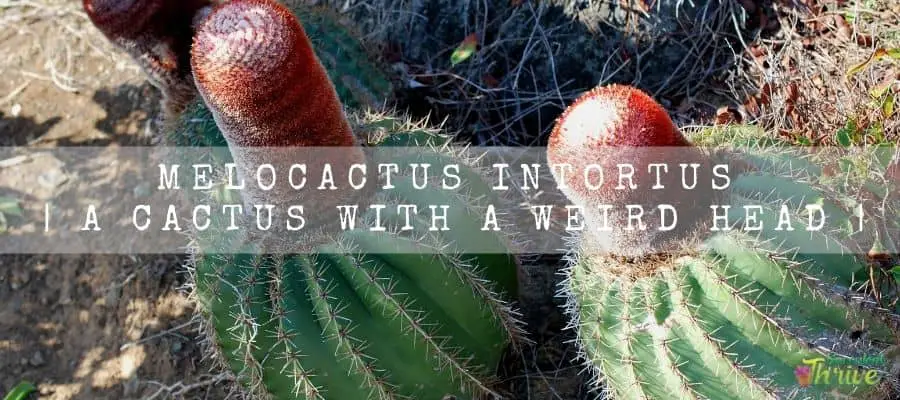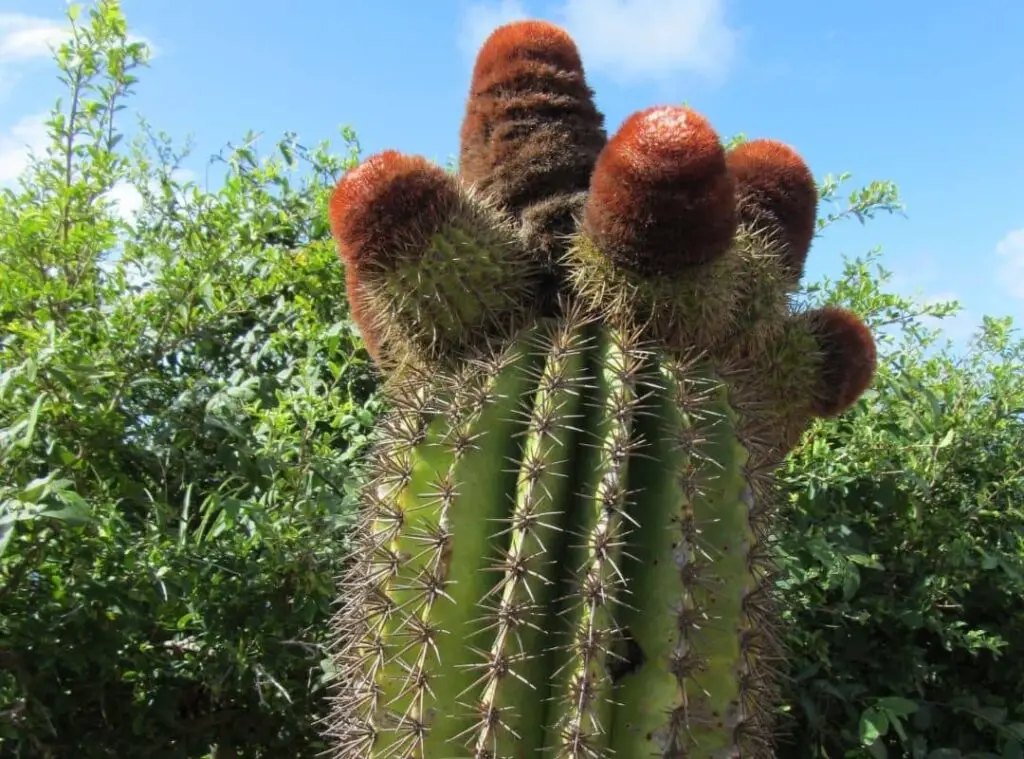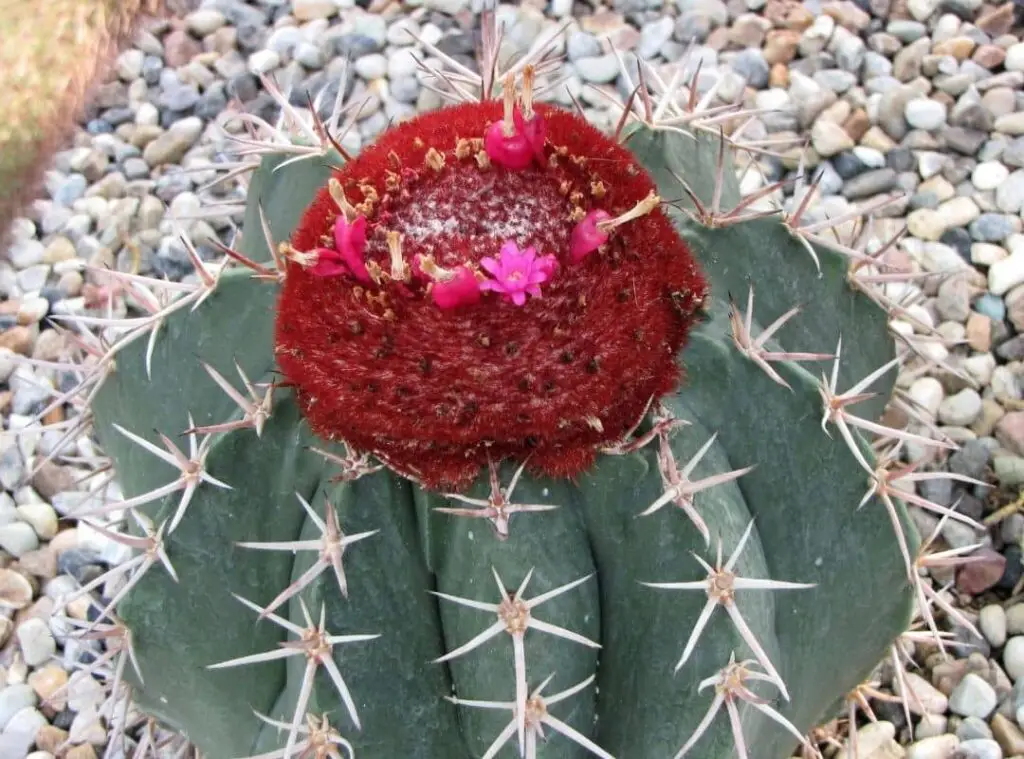Melocactus intortus is a fantastic cactus you may find in the cactus world. They are unique looking and have their own beauty.
The highlight of the Melocactus intortus is their cephalium and it will be more like the summit of these plants.
They would grow their cephalium when they fully mature. So, if you are a curious succulent cactus lover, you can keep reading this article.

Having said that I do not recommend this for the freshers to start growing as they require a somewhat difficult maintenance.
Turk’s head cactus is what you could call these plants in common. Melocactus intortus are widely distributed in the southern island groupings of the Lucayan Archipelago as well as the Lesser Antilles.
Their natural habitats would be Shrublands and Dwarf Shrublands, and Rocky Shores.
How do I identify Melocactus intortus?
You can identify the Melocactus intortus by their cephalium as aforesaid. They would usually grow as solitary plants.
If we consider the immature Melocactus intortus, they will tend to look like small barrel cactus. Melocactus intortus stem would tend to take a round conical shape.
They would consist of ribs which would form longitudinally. They would be 20 cm in height and 20 cm in diameter. The Melocactus intortus cephalium would be white in color. Moreover, they would consist of red bristles too.
Melocactus intortus are a flowering set of plants. They produce flowers in bright pink to purple and they would arise in the cephalium.
Those flowers would be about 1 cm wide. You could spot their calyx carrying sepals in pink too. Furthermore, Melocactus intortus would produce fruits which are red or bright pink in color.
They would tend to take a pear shape as well. They may also contain numerous seeds too. You could spot those seeds in black.
Melocactus intortus grows as unbranched plants. They would reach a maximum height of 75 cm. Moreover, they would be about 35 cm in width. Melocactus intortus may consist of 20 ridges. They would produce radiating spines 1-2 cm apart.
Growth rate
Melocactus intortus are a slow growing set of plants.
One look care guide
| Botanical Name | Melocactus intortus |
| Common Name | Turks head cactus |
| Plant Type | Cactus |
| Mature Size | 20 cm in height and in width |
| Sun Exposure | Full sunlight |
| Soil Type | Well-draining |
| Soil pH | Acidic to neutral |
| Flower Color | bright pink to purple |
| Hardiness Zones | USDA hardiness zones 10-11 |
| Native Area | Southern island groupings of the Lucayan Archipelago |
| Toxicity | Non-Toxic |
| Average price | USD 7 |
How do you take care of Melocactus intortus?
Light Requirement
You should ensure that you leave them under full sunlight so that it will allow them to grow to their fullest.
Literally, ensure that you expose them for at least six hours of sunlight preferably in the morning hours. When you grow them as indoor plants, place them near a bright sunny window.
When it is summer, you can bring them outdoors and expose them to some direct sunlight. However, when you bring them outdoors, make sure that you do it gradually. Unless it would make them traumatized.
Temperature and humidity
Melocactus intortus do not tolerate colder weather. Hence ensure that you expose them for temperatures above 8-12 degrees Celsius always.
The exposure to frost can even result in the death of the plants. When you grow them indoors, do not place them closer to cold drafts as it could also cause changes in humidity.
Having said that, humidity is not something which you should worry about as long as you grow them in a soil medium which has excellent drainage.
Is it cold hardy?
USDA Hardiness Zone
Melocactus intortus preferred USDA hardiness zones are 10-11.
Watering Requirement
Melocactus intortus would thrive well with moderate watering. If you feel like their soil is dry, you can consider watering them.
If you wish to still ascertain whether their soil is dry, , you can simply place your finger in the soil and check the status of it.
If you feel like their soil is moist, you need to wait for a couple of days and then water. Do not ever let their soil become bone dry as they cannot withstand long stretches of dryness. On the other hand,over watering could result in diseases such as root rot.
Soil Requirement Type / pH
It would be beneficial for the Melocactus intortus’ optimal growth if you provide a sandy or rocky soil mix for them. Additionally it has to be a well draining soil mix.
if you grow them in a poor draining soil mix, it will result in root rot. Moreover, it would make them more vulnerable for other bacterial infections as well.
If you grow them as container plants, you may go ahead with a well-draining cactus potting mix. When it comes to the right ph. of the soil mix, best would be to provide a soil mix which is acidic to neutral.

Pot size Potting and Repotting
A pot which has good drainage would be ideal to grow the Melocactus intortus.
Moreover, consider growing them in a porous material pot as they would evaporate excess moisture faster.
I recommend using Unglazed clay pots for them. I recommend growing the plants in slightly larger pots than the plants root ball.
When it comes to repotting, you may conduct it once every two years. Melocactus intortus have a weak root system and they find it difficult to establish due to that.
If you spot the plants have outgrown from the pots, you can consider repotting them. If you consider repotting them, I suggest you wait until spring comes, as it would be beneficial for the optimal growth of the plants.
You can simply follow the same steps that you do repot other cacti when repotting these plants. However keep in mind that you need to plant them in the same depth as initially when you plant them freshly in the new pot.
Where to Plant
Melocactus intortus have strong requirements when it comes to light. Hence when you grow them in a place, ensure that you ensure they can absorb sufficient sunlight.
Fertilizer and time of year
You can go ahead with a balanced cactus or a succulent fertilizer to feed the Melocactus intortus. You need to apply those fertilizers during spring and summer so that it would stimulate the growth of the plants. Suspend feeding them in winter and in fall.
Flower
Melocactus intortus produce flowers in pink to purple. They would be about 1 cm in diameter.
Dormancy
Toxicity
There are no records to emphasize on the Melocactus intortus toxicity.
Common bugs and illnesses
Melocactus intortus are a hardy versatile set of plants and they can overcome pests attacks usually.
Having said that, you need to watch out for pests such as aphids, mealybugs, and spider mites. Moreover if you end up watering them in abundance, it would lead to root rot.. It would further make the plants more vulnerable for other bacterial infections.
Special Care tips
I encourage you to wear gloves before you interact with the plants so that their bristles would not harm you.

How to propagate the Melocactus intortus
You can conduct the propagation of the Melocactus intortus through seeds. Best season to conduct the propagation would be February to March.
You can simply lay them in a sandy porous soil mix and cover the germination tray with a layer of glass. Ensure that you maintain a temperature range of 18-22 degrees Celsius during this process.
Conclusion
Hope this article was a useful one for you and it made you excited to start growing these precious plants. These are worth having plants and when they flourish , you will feel accomplished.
Read Next : Melocactus Curvispinus | Cactus With A Weird Head | Melocactus Matanzanus | Cactus With A Weird Head |
